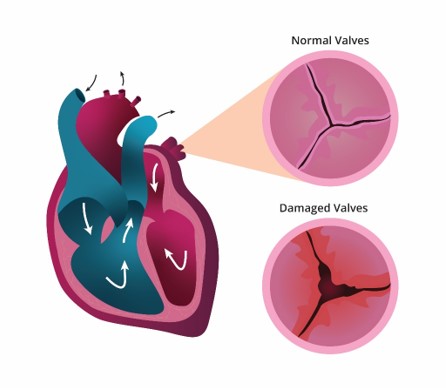What is rheumatic heart disease?
Rheumatic heart disease (RHD) refers to damaged heart valves (see Figure 1.1) because of one or more episodes of ARF. An affected heart valve can become scarred and/or stiff, impacting blood flow. The mitral and aortic valves are most frequently affected. Regurgitation, the backwards flow of blood, due to damage to the mitral valve, is the most common feature of RHD.
Figure 1.1: Diagram of the heart, comparing normal and damaged valves.

Source: AIHW
The type of valve affected and severity of damage, along with a history of ARF, are important clinical indicators for RHD diagnosis. Symptoms of RHD include fatigue, chest pain, swelling of legs, and shortness of breath. Diagnosis can be difficult as symptoms are shared with other cardiac diseases. However, many patients can remain asymptomatic despite having moderate or severe RHD.
If left untreated, RHD can cause arrhythmias (heart beats too fast, too slow, or irregularly), stroke, endocarditis (inflammation of the inner lining of the heart or its valves), and complications of pregnancy, and may be fatal.
Management of RHD includes treating symptoms and preventing worsening of disease, which requires regular medical imaging to monitor which valves are damaged and how badly. Management is complex and can involve coordination of multiple services and treatments such as primary health care, secondary prophylaxis with penicillin, and other specialist care (RHDAustralia 2020).
RHDAustralia (ARF/RHD writing group) (2020) ‘The 2020 Australian guideline for the prevention, diagnosis and management of acute rheumatic fever and rheumatic heart disease’, 3.2 edn (2022), RHDAustralia, Menzies School of Health Research, Darwin.


